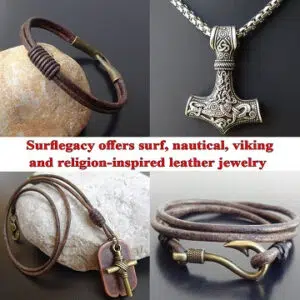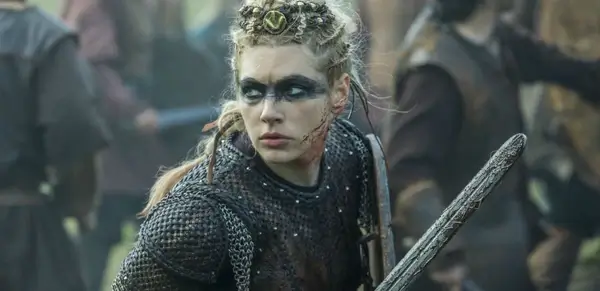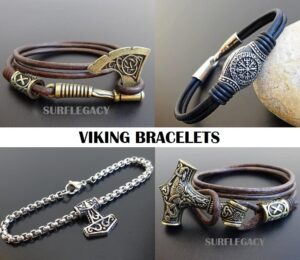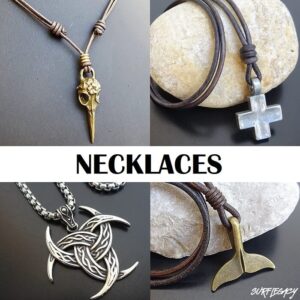Did the Vikings paint their faces? Is there any evidence? If so, how did they do it? Why did they do it? What was the result? In this article, we’ll try to answer all these questions with actual facts.
The Vikings were a fierce and warlike people who had a strong cultural identity. They traveled widely, and many of them settled in the Baltic region, Ireland, Normandy, and Britain. They were also known for their seafaring prowess. Their ships were often referred to as longships, and they were often armed with oars, shields, and swords.
Many portrayals of Vikings in popular culture depict them as fierce muscular men with painted faces. It’s good to enjoy a program like Vikings, but you might be wondering which aspects of the show’s depictions of Viking society are true or false.
Did the Vikings Actually Paint Their Faces?
Short answer: Yes
Long answer: Their facial painting was more aimed at enhancing their facial beauty traits and eyes, rather than for battling the enemy on the field.
Viking face paint was probably used far less frequently than modern people imagine or see in movies.
Surprisingly, little is known about Viking lifestyle and facial painting traditions.
However, when we examine at the historical record, we can discover that there are a few recorded instances of people visiting Viking territories and taking notice of how the Vikings appeared.
Is There Any Evidence That The Vikings Painted Their Face?
Yes, there is some evidence showing this claim both in literature and in archaeological findings
Viking Face Paint Literature Evidence
The Vikings were also a civilization centered on oral storytelling traditions, we have very few written documents regarding their knowledge as everything was mostly handed down orally.
After some research, we could find two distinct pieces of evidence that the Vikings painted their faces, however, neither explains why they did so.
The first documented account of the Vikings’ physical appearance comes from a letter written in ancient English by lfric, Abbot of Eynsham, to an anonymous ‘Brother Edward’ protesting about certain Englishmen who cut their hair in the Danish style (length in front, short behind) during the Viking invasion of England (ca A.D. 1000).
In the letter he also talks about “blinded eyes” he does not say much more than that, however, the blinded eyes can be interpreted as a kind of eyeliner around the eyes.
The other more substantial evidence comes from Ibn Fadlan, a diplomat from the Abbasid court in Baghdad to the Turkic Bulgars who resided near the Volga River. During his mission to their king in 921, he encountered several Viking trading groups.
Ibn Yaqub also mentions the use of face paint by the Vikings and that it was made from a plant called ‘aubas’ which has been identified as the common name for the plant ‘Fraxinus excelsior’ or ‘ash tree’.
The first recorded use of Kohl was in the 6th century in Persia. It was later adopted by the Greeks and Romans. In the Middle Ages, it was used in the Eastern Orthodox Church and in Russia.
Another example is a brief reference by Ibrahim ibn Yaqub, an Arab traveler from Cordova, Spain. In the 10th century, he went around Europe and published a commentary on the habits, activities, and customs of individuals from various civilizations, including Vikings.
When he visited the Viking settlement of Hedeby in 965 he observed that “both men and women apply a type of indelible cosmetic to enhance the attractiveness of their eyes.”
He also claimed that the Danes used Kohl to line their eyelids. Kohl is a black powder, which is usually antimony sulfide or lead sulfide, used to enhance or improve a person’s appearance. According to Yaqub’s remark, it was common for Vikings to apply a foreign material to their faces in order to improve or enhance their looks.
Viking Face Paint Archaeological Evidence
A few years ago, archaeologists unearthed a burial site (see also our article Viking Funeral) near the village of Oseberg in Norway. This site had been used for burial practices for at least 500 years.
The burial site contained the remains of three women who had been buried in the early Viking Age. One of the women was buried with a ring, an ornamented brooch, a sword, and a shield.
A number of other grave goods were also recovered, including a silver bowl and a bronze vessel. An analysis of the remains of the women showed that they had died at around age 40, and that they were buried with items that were not made of precious metals, which would be common for the period.
However, they were buried with an assortment of jewelry that included two gold earrings, a gold pendant, a gold ring, a silver necklace, and a gold bracelet. Additionally, a red ochre pigment was found on the faces of all three women.
In certain circumstances, unexpected archaeological discoveries are produced. For example, there is the unusual Viking woman’s grave discovered near Hobro in Denmark in the ring stronghold of “Fyrkat.” It distinguishes out among the site’s about 30 burials due to its distinctive grave items.
It was the burial of a female, maybe a seer. The woman was buried in exquisite blue and crimson clothing decorated with gold thread, indicating her regal position. She was buried in the corpse of a horse-drawn carriage, as were the wealthy ladies. She’d been given typical feminine presents such as spindle whorls and scissors.
A metal wand and seeds from the poisonous henbane plant were found in the grave. The seeds could have been used as a “witch’s salve” to produce a psychedelic effect if thrown into a fire. Her belt buckle had some white lead, also known as lead carbonate, which was occasionally used as a component in skin makeup.
Lead carbonate was a prevalent kind of ancient cosmetics used by the Greeks, who referred to it as “white lead.” Historians were unsure if the white lead was used by the seeress because there was no evidence of it on the bodies discovered in the burial.
What Did Vikings Use to Paint Their Faces?
Some Vikings painted their faces with dark kohl, bordering the area around their eyes. Kohl was manufactured at the time from a mixture of lead sulfide and antimony sulfide. These chemicals become poisonous to the user over time. They caused pockmarked skin and aided in lead poisoning.
Vikings may have employed various, less poisonous chemicals to embellish their features in different areas. Charcoal was a popular source of black powder or dark pigment, which any Viking might use provided they had access to fire ashes. Vikings utilized binders such as eggs or linseed oil to make a paste that could be applied to the face.
Natural pigments and charcoal were blended with linseed oil to create paints that Vikings used on their dwellings, shields, and ornamental items. We must assume that they went through a similar process to create some sort of makeup.
If they did, however, all records of it have been lost since there is no evidence that has survived to the present day that can be considered strong proof except that one of Ibrahim ibn Yaqub, which we have mentioned earlier in this article.
Did Vikings Paint Their Face For Battle?
If Vikings painted their faces during battle, there is no real proof ever documented to support this idea. We seriously doubt they would because it would not be practical at all, as this would have prevented identifying other Vikings in the most frantic moments of a battle.
This also would lead to another problem, someone could have replicated their face paint and sneakily attacked them, with devastating consequences for their safety.
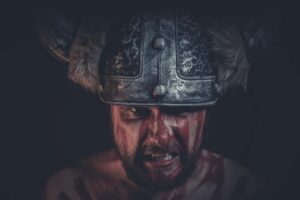
Viking Face Paint Meanings
Many people may believe that the Vikings painted their faces in order to look more intimidating in battle. Ultimately, we don’t know for sure if Vikings actually painted their faces before battle, as there is no real evidence to support this claim.
The Vikings were a fierce and warlike people, and they were often seen as barbaric by their enemies. But the Vikings were also a people who placed a great deal of importance on appearance, and they took great care to make sure that they looked their best. One way that they did this was by painting their faces to enhance their facial features. The paint would have made their eyes look brighter and their cheekbones more pronounced.
The Vikings were people very concerned about their appearance, and they believed that painting their faces would make them more attractive.
Men and women both painted their eyes, but in various ways. Men did it to look more manly, while women did it to enhance their femininity. This custom was clearly not designed for battle. So the main purpose of using facial paints for the Vikings was to increase attractiveness to the opposite sex (see next paragraph)
What Did Vikings Look Like?
The Vikings were people very clean and took good care of themselves, while a lot of people think that Vikings were dirty and uncivilized.
Many legends portray Vikings as brutal and filthy soldiers. This representation is historically oversimplified and based in part on misconceptions of what people in the Middle Ages were like. Many Viking tombs include combs hidden away in boxes, indicating that they took their grooming seriously.
Prior of St. Fridswides, English Cleric John Wallingford, wrote about how Vikings bathed on weekends and changed their woolen clothing regularly, attracting high-bred English ladies in the process.
As previously stated, Yaqub’s writings are the only historical text that gives the impression that the Vikings were filthy. He described how Vikings spit and blow their noses into bowls before passing them on to the next man.
Given his Islamic ideas on how to cleanse the body, some historians believe Yaqub may have exaggerated. It is likely that the bowls were emptied before being refilled for use by another individual, in which case Ibrahim Yaqub would have regarded them unclean.
Except for Yacqub, practically every other source claims that Vikings were among the cleanest people in Europe during the Middle Ages.
In the summer, they bathed in lakes, streams, and bathhouses, while in the winter, they bathed in heated bathhouses. They also cleaned their hands and faces every morning as they got out of bed. If you want to know more see also our article “What did Vikings look like?”
How Do You Make Your Own Viking Face Paint?
Keep in mind that most of our current conceptions of Viking facial paint are based on popular movies and stories that aren’t historically true. The majority of conceptions of terrifying, painted warriors are based on fiction.
You might begin by decorating your face with thick black eyeliner around your eyes. Please be cautious and avoid attempting to employ archaic formulations such as lead, which is extremely poisonous and can have major health consequences.

If you want to try something different then all you need is some natural pigment, a bowl of water, and a brush. Start by mixing the pigment with water in the bowl. You want to create a thin paste that is easy to apply to your skin.
Once you have the desired consistency, dip your brush into the pigment and start painting your face. There is no set design for Viking face painting. You can be as creative as you want. You use both black and bright colors, this depends on the contest you will wear the facial paint.
Vikings were known for their courage, so don’t be afraid to be daring with your design. Once you’re happy with your design, allow the paint to dry. Then you’re ready to face the world like a true Viking!
Conclusion
It is still unclear whether or not the Vikings painted their faces, but it is most likely that they did not do so for battle purposes. if they did paint their faces, it was most likely for the purpose of making themselves more attractive, rather than for other purposes.
Shop Viking Jewelry
Are passionate about Vikings or Norse Mythology? Finding the ideal piece of Norse Jewelry can be challenging, especially if you lack inspiration or don’t know where to look.
Surflegacy, on the other hand, has you covered. We have a wide range of Viking Jewelry in various styles, shapes, colors, and materials, to accentuate your Viking Spirit and look.
Whatever you wear, you’ll find the ideal trendy piece to complement your wardrobe. Our jewelry is designed to be worn every day, no matter where you go or what season is. Are you ready to step up your wardrobe game? Visit our shop here
